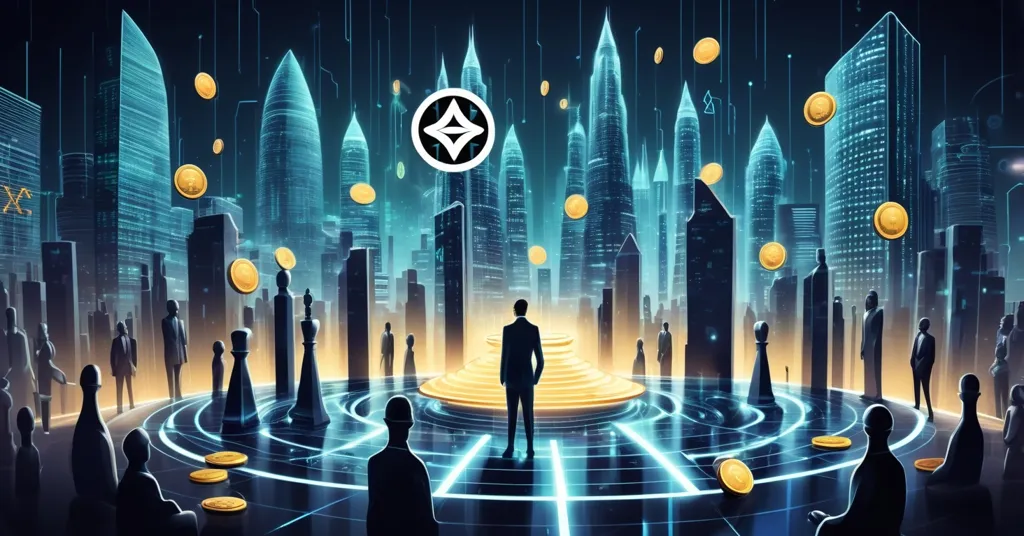XRP Price Jumps 4% to $2.38 as Ripple Bets Big with $1B Treasury and Acquisitions

XRP Surges with Gutsy Rebound as Investors Pile In and Ripple Doubles Down
XRP is back in the spotlight, roaring with a 4% price jump in just 24 hours to $2.38, shaking off a recent slump to $2.25—its lowest since early July. This isn’t just a random blip on the charts; it’s fueled by hardcore investor accumulation and Ripple’s audacious moves to carve out a dominant spot in global digital finance.
- Price Rally: XRP climbs over 4% to $2.38, rebounding from a July low of $2.25.
- Investor Confidence: Record 317,500 wallets hold at least 10,000 XRP, a historic high.
- Ripple’s Power Plays: A $1B Digital Asset Treasury and $3B in acquisitions signal big ambitions.
Price Rally and Investor Trust: A Solid Foundation?
This uptick isn’t just chart noise—it’s backed by a flood of investors betting big on XRP. Data from BeInCrypto pegs the price recovery at over 4% in a single day, a sharp turnaround from a rough patch. But the real kicker comes from on-chain analytics by Santiment, showing the number of wallets holding at least 10,000 XRP has soared to an all-time high of about 317,500. For context, that’s a significant leap from previous years and outpaces accumulation trends in many other altcoins, signaling that mid- to large-sized holders aren’t just dipping a toe—they’re diving headfirst into XRP. This kind of behavior often reflects a belief in long-term value, not just a quick flip for profit.
Now let’s zoom out on the speculative side. According to CoinGlass, open interest in XRP futures has tanked to $3.49 billion, the lowest since June. For those new to the term, open interest is like the total number of open bets at a racetrack—it measures the value of unsettled derivative contracts. A drop like this means fewer traders are making risky, leveraged plays on XRP’s price swings. Less gambling, less chaos. Historically, when the speculative crowd steps back, it can signal a market bottom, clearing the way for a price rise based on real value, not hype. Is this the calm before a fundamentals-driven storm for XRP? The signs are there, but don’t pop the champagne just yet.
Ripple’s Strategic Gambits: Building a Financial Fortress
Ripple, the company steering XRP, isn’t twiddling its thumbs while the market plays out. They’ve unveiled a $1 billion Digital Asset Treasury (DAT) to manage and stockpile XRP as a long-term reserve. Picture it as a financial bunker, ensuring there’s enough XRP liquidity to weather crypto’s notorious volatility. But they’re not stopping at hoarding—Ripple has splashed out roughly $3 billion on acquisitions to construct a robust ecosystem. Companies like Metaco, Hidden Road, Rail, and GTreasury are now under their umbrella, each piece aimed at weaving XRP and the Ripple USD (RLUSD) stablecoin into the fabric of corporate finance.
Let’s break that down a bit. Metaco, for instance, specializes in crypto custody solutions for institutions—think of it as a high-security vault for digital assets. By snapping up Metaco, Ripple is positioning XRP as a go-to option for banks and big businesses looking to dip into crypto without the Wild West risks. RLUSD, meanwhile, is Ripple’s stab at a stablecoin, a cryptocurrency tied to the U.S. dollar to avoid price gyrations, meant to complement XRP’s strength in cross-border payments. These aren’t just flashy purchases; they’re calculated steps to create tools and systems for businesses to use crypto seamlessly. In a space littered with half-baked ideas, Ripple’s focus on utility feels like a rare dose of substance in a hype-drunk market.
Picture a future where your international wire transfer clears in seconds, not days—Ripple’s banking on XRP to make that happen. Their vision is to transform cryptocurrencies from speculative toys into practical tools for corporations and institutions. Whether it’s slashing the cost and time of global transactions or providing a stable bridge for businesses wary of crypto’s rollercoaster, Ripple is playing a long game. But execution is everything—can they stitch these acquisitions into a working machine, or will it be another crypto pipe dream? That’s the billion-dollar question.
Regulatory Wildcards: The SEC Shadow Looms Large
Speaking of hurdles, the U.S. Securities and Exchange Commission (SEC) remains the elephant in the room. Ripple’s legal battle with the SEC, which kicked off in late 2020 over whether XRP should be classified as a security, still casts a long shadow. A resolution hasn’t fully materialized as of late 2024, and every price surge comes with a nagging “what if” tied to regulatory action. Could a harsh ruling or further delays tank investor confidence overnight? It’s happened before—XRP took a brutal hit post-lawsuit filing, dropping over 60% in weeks.
On the flip side, there’s a tantalizing carrot dangling: the potential SEC approval of an XRP ETF. For those unfamiliar, an ETF (Exchange-Traded Fund) is an investment product traded on stock exchanges that tracks an asset’s value—here, XRP. Approval would let institutional investors jump in without directly holding the token, a massive boost to credibility and adoption. Recent buzz around applications for leveraged XRP ETF products, which amplify price bets, has the community hyped. Let’s cut the crap, though—most of these leveraged ETF dreams are pure gambling, not investment. Still, a green light from the SEC could be a turning point, especially after years of scrutiny. Look at Bitcoin and Ethereum ETFs; their approvals spiked market caps by billions almost instantly. For XRP, it could mean the same—or it could be a crushing rejection. Regulatory roulette, anyone?
The Bigger Picture: XRP in a Crowded Crypto Arena
Stepping back, XRP’s rally unfolds against a 2024 crypto market teeming with contradictions—record adoption in some sectors, gut-wrenching sell-offs in others. Bitcoin, the big daddy of decentralization, often sets the tone, and its price swings can drag altcoins like XRP along for the ride. Right now, with BTC showing mixed signals in a potential bull cycle, XRP’s surge might be riding coattails as much as fundamentals. Ripple’s aggressive acquisitions mirror a broader industry trend: consolidation. Major players are bulking up to survive a maturing, cutthroat landscape. But risks abound—beyond regulation, market sentiment can flip on a dime, and Ripple’s grand plans could stumble if integration falters.
Now, let’s throw on the Bitcoin maximalist hat for a moment, since we’re all about decentralization and shaking up the status quo. XRP isn’t Bitcoin—far from it. Ripple’s heavy hand in its ecosystem makes it centralized by design, a sore spot for purists who see BTC as the only untainted bastion of financial freedom. Bitcoin operates on a fully decentralized network with no central authority, while Ripple holds significant sway over XRP’s supply and direction. But here’s the devil’s advocate take: does every blockchain need to be Bitcoin? XRP carves out a niche in cross-border payments and corporate integration—areas where BTC’s slower transaction times (around 10 minutes to settle) and higher fees (often $1-5 per transaction) can’t compete. XRP transactions clear in 3-5 seconds for pennies. In the spirit of effective accelerationism, shouldn’t we root for tech that drives the financial revolution forward, even if it’s not perfectly pure? XRP could be the gateway for institutions Bitcoin can’t yet win over, laying groundwork for wider crypto adoption. That’s not nothing, even if it doesn’t wear the maximalist crown.
Looking Ahead: Can XRP Keep the Momentum?
So, where does XRP stand? The bullish vibe is hard to ignore—investors are stacking up, Ripple is playing chess while others play checkers, and ETF speculation adds a wildcard spark. But the ghosts of regulation and execution risks linger. A misstep in integrating their shiny new acquisitions or a harsh SEC ruling could send XRP tumbling as fast as it rose. And let’s not even entertain the charlatans peddling $10 price predictions by Christmas—we’re not here to pump XRP or sell moonshot fantasies. The data speaks, but the risks scream just as loud. XRP’s got the wind at its back for now, but will it soar or crash under the weight of its own ambition?
Looking further out, XRP’s trajectory might hinge on uncharted territory. Could partnerships with central banks for digital currencies (CBDCs) be next, given Ripple’s enterprise bent? Might we see XRP embedded in more payment systems by 2025? These are the questions worth pondering as this saga unfolds. For now, it’s not just another pump-and-dump; there’s meat on these bones, gristle and all.
Key Questions on XRP’s Resurgence
- What’s driving XRP’s price jump to $2.38?
A potent combo of investor accumulation—record wallets holding 10,000+ XRP—and Ripple’s strategic moves like the $1 billion Digital Asset Treasury are pushing the 4% surge. - Why does the drop in XRP futures open interest matter?
Plummeting to $3.49 billion, the lowest since June, it shows speculative trading is easing, often a sign of a market bottom before a recovery rooted in real value. - Could an XRP ETF approval change the game?
Without a doubt—SEC approval could unleash institutional money and legitimacy, potentially stabilizing XRP and boosting its market standing. - How do Ripple’s acquisitions shape XRP’s future?
Dropping $3 billion on firms like Metaco for crypto custody, Ripple is crafting infrastructure to embed XRP and RLUSD in digital finance, aiming for long-term utility. - Is XRP’s rally sustainable?
It’s promising but shaky—sustainability depends on regulatory clarity, broader market trends, and whether Ripple can deliver on its ambitious roadmap. - Why does XRP’s centralization spark debate?
Unlike Bitcoin’s decentralized network, Ripple’s control over XRP rubs purists the wrong way, though its speed and cost advantages offer unique value in payments. - How does XRP compare to Bitcoin in utility?
XRP shines in cross-border transactions with near-instant settlements and low fees, while Bitcoin prioritizes decentralization over speed, serving different financial niches.



